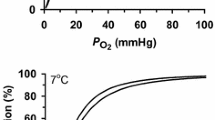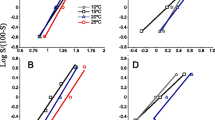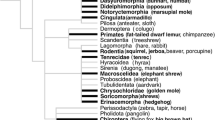Abstract
Along with the periodic reductions in O2 requirements of mammalian hibernators during winter, the O2 affinity of the blood of mammalian hibernators is seasonally regulated to help match O2 supply to consumption, contributing to limit tissue oxidative stress, particularly at arousals. Specifically, mammalian hibernators consistently show an overall increase in the blood–O2 affinity, which causes a decreased O2 unloading to tissues, while having similar or lower tissue O2 tensions during hibernation. This overview explores how the decreased body temperature and concentration of red blood cell 2,3-diphosphoglycerate (DPG) that occur in hibernation contribute separately or in combination to the concurrent increase in the O2 affinity of the hemoglobin, the O2 carrier protein of the blood. Most mammalian hemoglobins are responsive to changes in DPG concentrations, including that of the hibernating brown bear, although the smaller hibernators, such as golden-mantled ground squirrel, chipmunks, and dormice, have hemoglobins with low sensitivity to DPG. While the effect of DPG on oxygenation may vary, the decrease in body temperature invariably increases hemoglobin’s O2 affinity in all hibernating species. However, the temperature sensitivity of hemoglobin oxygenation is low in hibernators compared to human, apparently due in part to endothermic allosteric quaternary transition in ground squirrels and dissociation of chloride ions in brown bears. A low heat of blood oxygenation in temporal heterotherms, like hibernators, may thus contribute to reduce heat loss, as found in regional heterotherms, like polar mammals, although the significance would be low in winter hibernation.



Similar content being viewed by others
References
Adelstein SJ, Lyman CP, O’Brien RC (1967) Cell proliferation kinetics in the tongue and intestinal epithelia of hibernating dormice (Glis Glis). In: Mammalian hibernation III. Oliver & Boyd, Edinburgh, pp 398–408
Bårdgard AJ, Strand I, Nuutinen M, Jul E, Brix O (1997) Functional characterisation of eskimo dog hemoglobin: I. interaction of Cl– and 2,3-DPG and its importance to oxygen unloading at low temperature. Comp Biochem Physiol A Physiol 117:367–373. doi:10.1016/S0300-9629(96)00286-1
Bartels H, Schmelzle R, Ulrich S (1969) Comparative studies of respiratory function of mammalian blood. V. Insectivora—shrew, mole and nonhibernating and hibernating hedgehog. Respir Physiol 7:278–286
Benesch R, Benesch RE (1967) Effect of organic phosphates from human erythrocyte on allosteric properties of hemoglobin. Biochem Biophys Res Commun 26:162–167
Benesch R, Benesch RE (1969) Intracellular organic phosphates as regulators of oxygen release by haemoglobin. Nature 221:618–622
Bennett-Guerrero E, Veldman TH, Doctor A, Telen MJ, Ortel TL, Reid TS, Mulherin MA, Zhu H, Buck RD, Califf RM, McMahon TJ (2007) Evolution of adverse changes in stored RBCs. Proc Natl Acad Sci USA 104:17063–17068. doi:10.1073/pnas.0708160104
Brix O, Thomsen B, Nuutinen M, Hakala A, Pudas J, Giardina B (1990) The chloride shift may facilitate oxygen loading and unloading to/from the hemoglobin from the brown bear (Ursus arctos L.). Comp Biochem Physiol Part B Comp Biochem 95:865–868. doi:10.1016/0305-0491(90)90330-V
Brown JCL, Chung DJ, Belgrave KR, Staples JF (2012) Mitochondrial metabolic suppression and reactive oxygen species production in liver and skeletal muscle of hibernating thirteen-lined ground squirrels. Am J Physiol Regul Integr Comp Physiol 302:R15–R28. doi:10.1152/ajpregu.00230.2011
Bullard RW, Funkhouser GE (1962) Estimated regional blood flow by rubidium 86 distribution during arousal from hibernation. Am J Physiol 203:266–270
Bunn HF (1980) Regulation of hemoglobin-function in mammals. Am Zool 20:199–211
Burlington RF, Whitten BK (1971) Red cell 2,3-diphosphoglycerate in hibernating ground squirrels. Comp Biochem Physiol 38:469–471
Burwell LS, Nadtochiy SM, Brookes PS (2009) Cardioprotection by metabolic shut-down and gradual wake-up. J Mol Cell Cardiol 46:804–810. doi:10.1016/j.yjmcc.2009.02.026
Carey HV (1990) Seasonal changes in mucosal structure and function in ground squirrel intestine. Am J Physiol Regul Integr Comp Physiol 259:R385–R392
Clausen G, Ersland A (1968) Respiratory properties of blood of hibernating hedgehog Erinaceus europaeus L. Respir Physiol 5:221–233
Clementi ME, Petruzzelli R, Filippucci MG, Capo C, Misiti F, Giardina B (2003) Molecular adaptation to hibernation: the hemoglobin of Dryomys nitedula. Pflugers Arch Eur. J Physiol 446:46–51. doi:10.1007/s00424-002-0960-4
Coletta M, Clementi ME, Ascenzi P, Petrzzelli R, Condó SG, Giardina B (1992) A comparative study of the temperature dependence of the oxygen-binding properties of mammalian hemoglobins. Eur J Biochem 204:1155–1157. doi:10.1111/j.1432-1033.1992.tb16741.x
Coletta M, Condo SG, Scatena R, Clementi ME, Baroni S, Sletten SN, Brix O, Giardina B (1994) Synergistic modulation by chloride and organic phosphates of hemoglobin from bear (Ursus arctos). J Mol Biol 236:1401–1406. doi:10.1016/0022-2836(94)90066-3
Damsgaard C, Storz JF, Hoffmann FG, Fago A (2013) Hemoglobin isoform differentiation and allosteric regulation of oxygen binding in the turtle, Trachemys scripta. Am J Physiol Regul Integr Comp Physiol 305:R961–R967. doi:10.1152/ajpregu.00284.2013
Dave KR, Prado R, Raval AP, Drew KL, Perez-Pinzon MA (2006) The arctic ground squirrel brain is resistant to injury from cardiac arrest during euthermia. Stroke 37:1261–1265. doi:10.1161/01.STR.0000217409.60731.38
de Groot H, Rauen U (2007) Ischemia-reperfusion injury: processes in pathogenetic networks: a review. Transplant Proc 39:481–484. doi:10.1016/j.transproceed.2006.12.012
Drew KL, Tøien Ø, Rivera PM, Smith MA, Perry G, Rice ME (2002) Role of the antioxidant ascorbate in hibernation and warming from hibernation. Comp Biochem Physiol Part C Toxicol Pharmacol 133:483–492. doi:10.1016/S1532-0456(02)00118-7
Drew KL, Harris MB, LaManna JC, Smith MA, Zhu XW, Ma YL (2004) Hypoxia tolerance in mammalian heterotherms. J Exp Biol 207:3155–3162. doi:10.1242/jeb.01114
Duhm J (1971) Effects of 2,3-diphosphoglycerate and other organic phosphate compounds on oxygen affinity and intracellular pH of human erythrocytes. Pflugers Arch Eur. J Physiol 326:341–356
Eddy SF, McNally JD, Storey KB (2005) Up-regulation of a thioredoxin peroxidase-like protein, proliferation-associated gene, in hibernating bats. Arch Biochem Biophys 435:103–111. doi:10.1016/j.abb.2004.11.020
Evans AL, Sahlén V, Støen OG, Fahlman Å, Brunberg S, Madslien K, Fröbert O, Swenson JE, Arnemo JM (2012) Capture, anesthesia, and disturbance of free-ranging brown bears (Ursus arctos) during hibernation. PloS One 7:e40520. doi:10.1371/journal.pone.0040520
Evans AL, Singh NJ, Friebe A, Arnemo JM, Laske TG, Fröbert O, Swenson JE, Blanc S (2016) Drivers of hibernation in the brown bear. Front Zool 13:7. doi:10.1186/s12983-016-0140-6
Fowler PA, Racey PA (1988) Overwintering strategies of the badger, Meles meles, at 57°N. J Zool 214:635–651. doi:10.1111/j.1469-7998.1988.tb03763.x
Franco M, Contreras C, Nespolo RF (2013) Profound changes in blood parameters during torpor in a South American marsupial. Comp Biochem Physiol A Mol Integr Physiol 166:338–342. doi:10.1016/j.cbpa.2013.07.010
Frerichs KU, Kennedy C, Sokoloff L, Hallenbeck JM (1994) Local cerebral blood flow during hibernation, a model of natural tolerance to “cerebral ischemia”. J Cereb Blood Flow Metab 14:193–205. doi:10.1038/jcbfm.1994.26
Frerichs KU, Smith CB, Brenner M, DeGracia DJ, Krause GS, Marrone L, Dever TE, Hallenbeck JM (1998) Suppression of protein synthesis in brain during hibernation involves inhibition of protein initiation and elongation. Proc Natl Acad Sci USA 95:14511–14516. doi:10.1073/pnas.95.24.14511
Geiser F (2004) Metabolic rate and body temperature reduction during hibernation and daily torpor. Annu Rev Physiol 66:239–274. doi:10.1146/annurev.physiol.66.032102.115105
Geiser F, Ruf T. (1995) Hibernation versus daily torpor in mammals and birds - physiological variables and classfication of torpor patterns. Physiol Zool 68:935–966
Græsli AR, Evans AL, Fahlman Å, Bertelsen MF, Blanc S, Arnemo JM (2015) Seasonal variation in haematological and biochemical variables in free-ranging subadult brown bears (Ursus arctos) in Sweden. BMC Vet Res 11:301. doi:10.1186/s12917-015-0615-2
Hanson A, Johansson BW (1961) Myocardial lactate concentration in guinea-pigs, normothermic and hypothermic, and hedgehogs, in a hibernating and a non-hibernating state. Acta Physiol Scand 53:137–141. doi:10.1111/j.1748-1716.1961.tb02271.x
Harkness D, Roth S, Goldman P (1974) Studies on the red blood cell oxygen affinity and 2,3-diphosphoglyceric acid in the hibernating woodchuck (Marmota monax). Comp Biochem Physiol Comp Physiol 48:591–599
Heldmaier G, Ortmann S, Elvert R (2004) Natural hypometabolism during hibernation and daily torpor in mammals. Hypoxic Hypometabolism 141:317–329. doi:10.1016/j.resp.2004.03.014
Hissa R, Siekkinen J, Hohtola E, Saarela S, Hakala A, Pudas J (1994) Seasonal patterns in the physiology of the European brown bear (Ursus arctos arctos) in Finland. Comp Biochem Physiol Comp Physiol 109:781–791
Hochachka PW, Somero GN (2002) Biochemical Adaptation: mechanism and process in physiological evolution. Oxford University, New York
Hock RJ (1957) Metabolic rates and rectal temperatures of active and hibernating black bears. Fed Proc 16:440–440
Janecka JE, Nielsen SSE, Andersen SD, Hoffmann FG, Weber RE, Anderson T, Storz JF, Fago A (2015) Genetically based low oxygen affinities of felid hemoglobins: lack of biochemical adaptation to high-altitude hypoxia in the snow leopard. J Exp Biol 218:2402–2409. doi:10.1242/jeb.125369
Jensen B, Storz JF, Fago A (2016) Bohr effect and temperature sensitivity of hemoglobins from highland and lowland deer mice. Comp Biochem Physiol A Mol Integr Physiol 195:10–14. doi:10.1016/j.cbpa.2016.01.018
Johansen K (1961) Distribution of blood in the arousing hibernator. Acta Physiol Scand 52:379–386. doi:10.1111/j.1748-1716.1961.tb02234.x
Johansen K, Lykkeboe G, Weber RE, Maloiy GMO (1976) Respiratory properties of blood in awake and estivating lungfish, Protopterus amphibius. Respir Physiol 27:335–345. doi:10.1016/0034-5687(76)90062-1
Jørgensen PG, Arnemo J, Swenson JE, Jensen JS, Galatius S, Frøbert O (2014) Low cardiac output as physiological phenomenon in hibernating, free-ranging Scandinavian brown bears (Ursus arctos)—an observational study. Cardiovasc Ultrasound 12:36. doi:10.1186/1476-7120-12-36
Kleinschmidt T, Sgouros J (1987) Hemoglobin sequences. Biol Chem Hoppe Seyler 368:579–615
Kowaltowski AJ, de Souza-Pinto NC, Castilho RF, Vercesi AE (2009) Mitochondria and reactive oxygen species. Free Radic Biol Med 47:333–343. doi:10.1016/j.freeradbiomed.2009.05.004
Kramm C, Sattrup G, Baumann R, Bartels H (1975) Respiratory function of blood in hibernating and non-hibernating hedgehogs. Respir Physiol 25:311–318
Kruman II, Ilyasova EN, Rudchenko SA, Khurkhulu ZS (1988) The intestinal epithelial cells of ground squirrel (Citellus undulatus) accumulate at G2 phase of the cell cycle throughout a bout of hibernation. Comp Biochem Physiol A Physiol 90:233–236. doi:10.1016/0300-9629(88)91109-7
Krutzsch PH, Hughes AH (1959) Hematological changes with torpor in the bat. J Mammal 40:547–554. doi:10.2307/1376274
Kurtz CC, Lindell SL, Mangino MJ, Carey HV (2006) Hibernation confers resistance to intestinal ischemia-reperfusion injury. Am J Physiol Gastrointest Liver Physiol 291:G895–G901. doi:10.1152/ajpgi.00155.2006
Lenfant C, Torrance J, English E, Finch CA, Reynafarje C, Ramos J, Faura J (1968) Effect of altitude on oxygen binding by hemoglobin and on organic phosphate levels. J Clin Invest 47:2652–2656
Lyman C, Hastings A (1951) Total CO2, plasma pH and PCO2 of hamsters and ground squirrels during hibernation. Am J Physiol 167:633–637
Maginniss LA, Milsom WK (1994) Effects of hibernation on blood-oxygen transport in the golden-mantled ground-squirrel. Respir Physiol 95:195–208
Maginniss LA, Tapper SS, Miller LS (1983) Effect of chronic cold and submergence on blood oxygen transport in the turtle, Chrysemys picta. Respir Physiol 53:15–29. doi:10.1016/0034-5687(83)90013-0
Mairbäurl H (1994) Red blood cell function in hypoxia at altitude and exercise. Int J Sports Med 15:51–63. doi:10.1055/s-2007-1021020
Mairbäurl H, Weber RE (2012) Oxygen transport by hemoglobin. Compr Physiol 2:1463–1489. doi:10.1002/cphy.c080113
Malan A (1982) Respiration and acid-base state in hibernation. In: Lyman CP, Willis JS, Malan A, Wang LC. (eds) Hibernation and torpor in mammals and birds. Academic Press, New York, pp 237–282
Malan A, Arens H, Waechter A (1973) Pulmonary respiration and acid-base state in hibernating marmots and hamsters. Respir Physiol 17:45–61
Malan A, Rodeau JL, Daull F (1985) Intracellular pH in hibernation and respiratory acidosis in the European hamster. J Comp Physiol B 156:251–258. doi:10.1007/BF00695780
McArthur MD, Jourdan ML, Wang LC (1992) Prolonged stable hypothermia: effect on blood gases and pH in rats and ground squirrels. Am J Physiol Regul Integr Comp Physiol 262:R190–R197
Milsom WK, Jackson DC (2011) Hibernation and gas exchange. Compr Physiol 1:397–420. doi:10.1002/cphy.c090018
Moncada S, Erusalimsky JD (2002) Does nitric oxide modulate mitochondrial energy generation and apoptosis? Nat Rev Mol Cell Biol 3:214–220. doi:10.1038/nrm762
Murphy MP (2009) How mitochondria produce reactive oxygen species. Biochem J 417:1–13. doi:10.1042/BJ20081386
Musacchia XJ, Volkert WA (1971) Blood gases in hibernating and active ground squirrels—HbO2 affinity at 6 and 38 C. Am J Physiol 221:128–130
Nelson RA, Ahner HW, Jones JD, Ellefson RD, Zollman PE (1973) Metabolism of bears before, during and after winter sleep. Am J Physiol 224:491–496
Ohta H, Okamoto I, Hanaya T, Arai S, Ohta T, Fukuda S (2006) Enhanced antioxidant defense due to extracellular catalase activity in Syrian hamster during arousal from hibernation. Comp Biochem Physiol Part C Toxicol Pharmacol 143:484–491. doi:10.1016/j.cbpc.2006.05.002
Okamoto I, Kayano T, Hanaya T, Arai S, Ikeda M, Kurimoto M (2006) Up-regulation of an extracellular superoxide dismutase-like activity in hibernating hamsters subjected to oxidative stress in mid- to late arousal from torpor. Comp Biochem Physiol Part C Toxicol Pharmacol 144:47–56. doi:10.1016/j.cbpc.2006.05.003
Orr AL, Lohse LA, Drew KL, Hermes-Lima M (2009) Physiological oxidative stress after arousal from hibernation in Arctic ground squirrel. Comp Biochem Physiol A Mol Integr Physiol 153:213–221. doi:10.1016/j.cbpa.2009.02.016
Osborne PG, Hashimoto M (2006) Brain antioxidant levels in hamsters during hibernation, arousal and cenothermia. Behav Brain Res 168:208–214. doi:10.1016/j.bbr.2005.11.007
Perutz MF (1972) Nature of haem–haem interaction. Nature 237:495–499. doi:10.1038/237495a0
Pomponi M, Bertonati C, Patamia M, Marta M, Derocher AE, Lydersen C, Kovacs KM, Wiig Ø, Bårdgard AJ (2002) Polar bear hemoglobin and human Hb A0: same 2,3-diphosphoglycerate binding site but asymmetry of the binding? Hemoglobin 26:363–371. doi:10.1081/hem-120016373
Popovic V (1964) Cardiac output in hibernating ground squirrels. Am J Physiol 207:1345–1348
Rauch JC, Hayward JS (1970) Regional distribution of blood flow in the bat (Myotis lucifugus) during arousal from hibernation. Can J Physiol Pharmacol 48:269–273. doi:10.1139/y70-045
Revsbech IG, Malte H, Fröbert O, Evans A, Blanc S, Josefsson J, Fago A (2013a) Decrease in the red cell cofactor 2,3-diphosphoglycerate increases hemoglobin oxygen affinity in the hibernating brown bear Ursus arctos. Am J Physiol Regul Integr Comp Physiol 304:R43–R49
Revsbech IG, Tufts DM, Projecto-Garcia J, Moriyama H, Weber RE, Storz JF, Fago A (2013b) Hemoglobin function and allosteric regulation in semi-fossorial rodents (family Sciuridae) with different altitudinal ranges. J Exp Biol 216:4264–4271. doi:10.1242/jeb.091397
Revsbech IG, Shen X, Chakravarti R, Jensen FB, Thiel B, Evans AL, Kindberg J, Fröbert O, Stuehr DJ, Kevil CG, Fago A (2014) Hydrogen sulfide and nitric oxide metabolites in the blood of free-ranging brown bears and their potential roles in hibernation. Free Radic Biol Med 73:349–357. doi:10.1016/j.freeradbiomed.2014.05.025
Richard V, Dodson GG, Mauguen Y (1993) Human deoxyhaemoglobin-2,3-diphosphoglycerate complex low-salt structure at 2·5 Å resolution. J Mol Biol 233:270–274. doi:10.1006/jmbi.1993.1505
Snapp BD, Heller HC (1981) Suppression of metabolism during hibernation in ground squirrels (Citellus lateralis). Physiol Zool 54:297–307
Storz JF (2016) Gene duplication and evolutionary innovations in hemoglobin-oxygen transport. Physiology 31:223–232. doi:10.1152/physiol.00060.2015
Storz JF, Weber RE, Fago A (2012) Oxygenation properties and oxidation rates of mouse hemoglobins that differ in reactive cysteine content. Comp Biochem Physiol A Mol Integr Physiol 161:265–270. doi:10.1016/j.cbpa.2011.11.004
Tanaka H (2006) Winter hibernation and body temperature fluctuation in the japanese badger, Meles meles anakuma. Zoolog Sci 23:991–997. doi:10.2108/zsj.23.991
Tempel GE, Musacchia XJ (1975) Erythrocyte 2,3-diphosphoglycerate concentrations in hibernating, hypothermic, and rewarming hamsters. Proc Soc Exp Biol Med 148:588–592
Tøien Ø, Drew KL, Chao ML, Rice ME (2001) Ascorbate dynamics and oxygen consumption during arousal from hibernation in Arctic ground squirrels. Am J Physiol Regul Integr Comp Physiol 281:R572–R583
Tøien Ø, Blake J, Edgar DM, Grahn DA, Heller HC, Barnes BM (2011) Hibernation in black bears: independence of metabolic suppression from body temperature. Science 331:906–909. doi:10.1126/science.1199435
Tufts DM, Revsbech IG, Cheviron ZA, Weber RE, Fago A, Storz JF (2013) Phenotypic plasticity in blood–oxygen transport in highland and lowland deer mice. J Exp Biol 216:1167–1173. doi:10.1242/jeb.079848
Twente JA, Twente JW (1968) Concentrations of L-lactate in the tissues of Citellus lateralis after known intervals of hibernating periods. J Mammal 49:541–544. doi:10.2307/1378226
Valeri CR, Hirsch NM (1969) Restoration in vivo of erythrocyte adenosine triphosphate, 2,3-diphosphoglycerate, potassium ion, and sodium ion concentrations following the transfusion of acid-citrate-dextrose-stored human red blood cells. Transl Res 73:722–733
Van Breukelen F, Martin SL (2001) Translational initiation is uncoupled from elongation at 18 °C during mammalian hibernation. Am J Physiol Regul Integr Comp Physiol 281:R1374–R1379
Van Breukelen F, Martin S (2002) Reversible depression of transcription during hibernation. J Comp Physiol B 172:355–361. doi:10.1007/s00360-002-0256-1
Volkert WA, Musacchia XJ (1970) Blood gases in hamsters during hypothermia by exposure to He-O2 mixture and cold. Am J Physiol 219:919–922
Weber RE, Campbell KL (2011) Temperature dependence of haemoglobin - oxygen affinity in heterothermic vertebrates: mechanisms and biological significance. Acta Physiol 202:549–562. doi:10.1111/j.1748-1716.2010.02204.x
Weber RE, Fago A (2004) Functional adaptation and its molecular basis in vertebrate hemoglobins, neuroglobins and cytoglobins. Respir Physiol Neurobiol 144:141–159. doi:10.1016/j.resp.2004.04.018
Weber RE, Lykkeboe G (1978) Respiratory adaptations in carp blood influences of hypoxia, red cell organic phosphates, divalent cations and CO2 on hemoglobin-oxygen affinity. J Comp Physiol 128:127–137. doi:10.1007/BF00689476
Weber RE (1992) Use of ionic and zwitterionic (Tris/Bistris and HEPES) buffers in studies on hemoglobin function. J Appl Physiol 72:1611–1615
Weber RE, Fago A, Campbell KL (2014) Enthalpic partitioning of the reduced temperature sensitivity of O2 binding in bovine hemoglobin. Comp Biochem Physiol A Mol Integr Physiol 176:20–25. doi:10.1016/j.cbpa.2014.06.012
Wells L (1971) Circulatory patterns of hibernators. Am J Physiol 221:1517–1520
Acknowledgements
We thank Roy E. Weber and three anonymous reviewers for useful comments on the manuscript. This work was funded by Danish Council for Independent Research, Natural Sciences for (Grant DFF 4181-00094 to AF).
Author information
Authors and Affiliations
Corresponding author
Additional information
Communicated by F. Breukelen.
This manuscript is part of the special issue Hibernation—Guest Editors: Frank van Breukelen and Jenifer C. Utz.
Rights and permissions
About this article
Cite this article
Revsbech, I.G., Fago, A. Regulation of blood oxygen transport in hibernating mammals. J Comp Physiol B 187, 847–856 (2017). https://doi.org/10.1007/s00360-017-1085-6
Received:
Revised:
Accepted:
Published:
Issue Date:
DOI: https://doi.org/10.1007/s00360-017-1085-6




